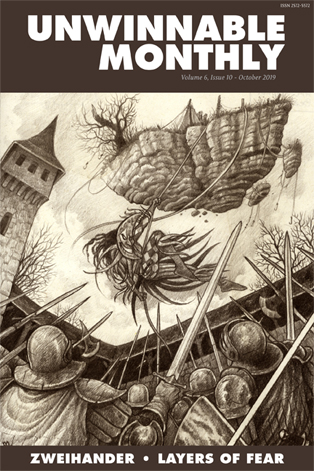
On Silence
 This column is a reprint from Unwinnable Monthly #120. If you like what you see, grab the magazine for less than ten dollars, or subscribe and get all future magazines for half price.
This column is a reprint from Unwinnable Monthly #120. If you like what you see, grab the magazine for less than ten dollars, or subscribe and get all future magazines for half price.
———
Revisiting stories, old and new
———
Can an argument be made for silence as an aesthetic virtue? To be successful, such an argument would have to be sincere. Irony may disarm, but a contingent, ironic virtue would be troublesome. The argument should not be that some art is to be silenced, but that silence itself may be productive, expressive and beautiful. Similarly, silence as an aesthetic tool can be useful only if self-imposed: a method and not a qualitative distinction — a provocation and not a response. Unfortunately, this last position is untenable. Silence is always a response to the inadequacy of speaking and can only be meaningful in the context of that speech.
I have been working to break a silence and am finding it difficult.
It is important to recognize the different kinds of silence. There is silence that is imposed, the result of a power differential, and is an element of the perpetuation of harm. We have begun to speak a bit about such silences, and it is difficult. It is also nothing less than a moral necessity. It is important to recognize the difference between that which is necessary and that which is sufficient.
There is a role for silence even in the breaking of this first kind of silence when one’s energy is used in support of other voices rather than speaking the words of the silenced in one’s own voice instead of theirs. This silence is not the same thing as declining to speak.
So much energy is directed towards maintaining the first kind of silence that it is difficult and sometimes dangerous to even speak of the second kind of silence.
[pullquote]It is important to recognize the difference between that which is necessary and that which is sufficient.[/pullquote]
The second kind of silence is silence that comes from within and not without. It is a silence marked by discipline and stillness, and the breaking of this second silence is sometimes a matter of sadness even when it is done with purpose and care.
The first silence is not and cannot be the second silence, and the danger in speaking of the second silence is that the virtues of that silence may be confused or misapplied as having anything to do with the first silence. The first silence is the silence of suffocation, and the second silence is the silence of meditation and prayer (even when it is neither meditation nor prayer).
And there are, of course, a multitude of silences that are neither the first silence nor the second silence. It would be easier were there only two.
It is not easy. It is difficult. It is necessary but not sufficient. It is possible for speech as well to be a sort of prayer.
It is good to not allow an aspiration to prayer to become a silence that is not prayer.
It is good to choose to be silent. It is good sometimes to speak. It is not easy. It is troublesome. It is difficult to be still.
It is difficult to speak in a manner that is worthy of breaking silence. It is good, sometimes, to try.
———
Gavin Craig is a writer and critic who lives outside of Washington, D.C.




